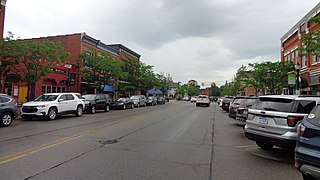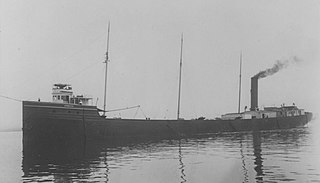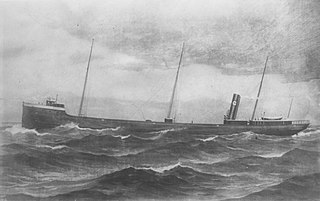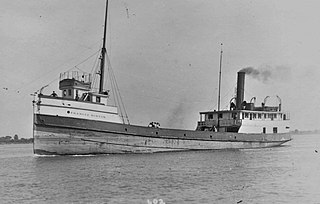
Lake Michigan is one of the five Great Lakes of North America. It is the second-largest of the Great Lakes by volume and the third-largest by surface area, after Lake Superior and Lake Huron. To the east, its basin is conjoined with that of Lake Huron through the 3+1⁄2-mile (5.6-kilometre) wide, 295-foot deep Straits of Mackinac, giving it the same surface elevation as its easterly counterpart; the two are technically a single lake.

Charlevoix County is a county in the U.S. state of Michigan. The county seat is Charlevoix. Located in the Northern Lower Peninsula, Charlevoix County is bisected by Lake Charlevoix, Michigan's third largest inland lake. As of the 2020 Census, the county's population was 26,054.

Boyne City is a city in Charlevoix County in the U.S. state of Michigan. The population was 3,816 at the 2020 census, making it the largest city in Charlevoix County. Boyne City is located at the eastern end of Lake Charlevoix, Michigan's third largest inland lake. The city is also the site of the mouth of the Boyne River, named for the River Boyne in Leinster, Ireland.

Boyne Valley Township is a civil township of Charlevoix County in the U.S. state of Michigan. The population was 1,195 at the 2010 census.

Charlevoix is a city in the U.S. state of Michigan. It is the county seat of Charlevoix County. Part of Northern Michigan, Charlevoix is located on an isthmus between Lake Michigan and Lake Charlevoix, bisected by the short Pine River. Charlevoix serves as the main access point for Beaver Island, the largest island in Lake Michigan, which can be accessed by Island Airways or carferry. The population of Charlevoix was 2,348 at the 2020 census. Charlevoix is mostly surrounded by Charlevoix Township, but the two are administered autonomously.

South Manitou Island is located in Lake Michigan, approximately 16 miles (26 km) west of Leland, Michigan. It is part of Leelanau County and the Sleeping Bear Dunes National Lakeshore. The uninhabited island is 8.277 sq mi (21.44 km2) in land area and can be accessed by a ferry service from Leland. Guided tours on open-air vehicles are available to visitors, but most traffic is on foot. Larger North Manitou Island lies to its north.

Northern Michigan, also known as Northern Lower Michigan, is a region of the U.S. state of Michigan. A popular tourist destination, it is home to several small- to medium-sized cities, extensive state and national forests, lakes and rivers, and a large portion of Great Lakes shoreline. The region has a significant seasonal population much like other regions that depend on tourism as their main industry. Northern Lower Michigan is distinct from the more northerly Upper Peninsula and Isle Royale, which are also located in "northern" Michigan. In the northernmost 21 counties in the Lower Peninsula of Michigan, the total population of the region is 506,658 people.
The Boyne City Railroad was a railway based at Boyne City, Michigan, U.S., during 1893–1978.

The SS Appomattox was a wooden-hulled, American Great Lakes freighter that ran aground on Lake Michigan, off Atwater Beach off the coast of Shorewood, Wisconsin in Milwaukee County, Wisconsin, United States in 1905. On January 20, 2005 the remnants of the Appomattox were listed on the National Register of Historic Places.

SS Milwaukee Clipper, also known as SS Clipper, and formerly as SS Juniata, is a retired passenger ship and automobile ferry that sailed under two configurations and traveled on all of the Great Lakes except Lake Ontario. The vessel is now docked in Muskegon, Michigan.

The history of commercial passenger shipping on the Great Lakes is long but uneven. It reached its zenith between the mid-19th century and the 1950s. As early as 1844, palace steamers carried passengers and cargo around the Great Lakes. By 1900, fleets of relatively luxurious passenger steamers plied the waters of the lower lakes, especially the major industrial centres of Chicago, Milwaukee, Detroit, Cleveland, Buffalo, and Toronto.

South Manitou Island Lighthouse is located on South Manitou Island in Lake Michigan, 16 miles (26 km) west of Leland, Michigan. It is in Leelanau County in western Northern Michigan.
The Detroit and Charlevoix Railroad is a defunct railroad that was located in Northern Lower Michigan. It was created to haul finished lumber from timber lands to market. It was acquired by the Michigan Central Railroad.

W.H. Gilcher was a steam lake freighter built in 1890–1891 by Cleveland Shipbuilding Company of Cleveland for Gilchrist, Gilcher & Schuck of Sandusky, with intention of transporting cargo between various ports located on Great Lakes. The ship was named after William H. Gilcher, one of the owners of the company. In October 1892 the freighter ran into a strong gale on Lake Michigan and foundered with the loss of eighteen men.

The SS Francis Hinton was a wooden-hulled steam barge that sank in a gale off the coast of Manitowoc, Wisconsin, on Lake Michigan in 1909 while heavily laden with a cargo of lumber. On December 16, 1996, the wreck of the Francis Hinton was listed on the National Register of Historic Places.

SS S.C. Baldwin was a wooden-hulled steam barge built in 1871, that capsized in a storm on August 26, 1908, on Lake Michigan, off Two Rivers, Wisconsin, United States, with the loss of one life. On August 22, 2016 the remnants of S.C. Baldwin were listed in the National Register of Historic Places as reference number 16000565.

The SS J.M. Allmendinger was a wooden-hulled steam barge built in 1883, that ran aground during a storm on November 26, 1895, on Lake Michigan, off the coast of Mequon, Ozaukee County, Wisconsin, United States. On October 11, 2018, the remains of J.M. Allmendinger were listed on the National Register of Historic Places.

Robert C. Pringle, originally named Chequamegon, was a wooden-hulled American tugboat that sank without loss of life on Lake Michigan, near Sheboygan, Wisconsin, on June 19, 1922, after striking an obstruction.

SS Ironsides was a wooden-hulled American package freighter in service between 1864 and 1873. She was built in 1864 in Cleveland, Ohio, by either Ira Lafrinier or Quayle & Martin. She was built for John E. Turner, also of Cleveland, and operated as part of the Cleveland & Lake Superior Line. She had an identical sister ship named Lac La Belle. Ironsides operated between Cleveland and Lake Superior for a number of years, and was sold several times. In 1869, she was sold to Nathan Englemann of Milwaukee, Wisconsin, and operated between Milwaukee and Grand Haven, Michigan. In 1871, she became part of the Englemann Transportation Company.

















